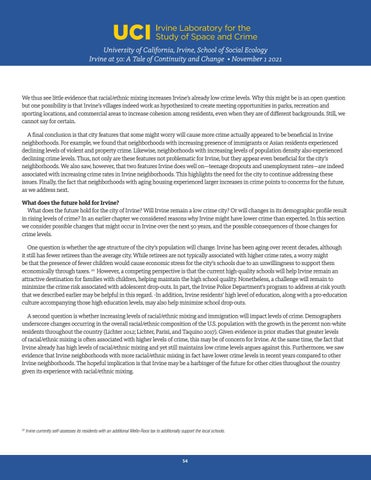University of California, Irvine, School of Social Ecology Irvine at 50: A Tale of Continuity and Change • November 1 2021
We thus see little evidence that racial/ethnic mixing increases Irvine’s already low crime levels. Why this might be is an open question but one possibility is that Irvine’s villages indeed work as hypothesized to create meeting opportunities in parks, recreation and sporting locations, and commercial areas to increase cohesion among residents, even when they are of different backgrounds. Still, we cannot say for certain. A final conclusion is that city features that some might worry will cause more crime actually appeared to be beneficial in Irvine neighborhoods. For example, we found that neighborhoods with increasing presence of immigrants or Asian residents experienced declining levels of violent and property crime. Likewise, neighborhoods with increasing levels of population density also experienced declining crime levels. Thus, not only are these features not problematic for Irvine, but they appear even beneficial for the city’s neighborhoods. We also saw, however, that two features Irvine does well on—teenage dropouts and unemployment rates—are indeed associated with increasing crime rates in Irvine neighborhoods. This highlights the need for the city to continue addressing these issues. Finally, the fact that neighborhoods with aging housing experienced larger increases in crime points to concerns for the future, as we address next. What does the future hold for Irvine? What does the future hold for the city of Irvine? Will Irvine remain a low crime city? Or will changes in its demographic profile result in rising levels of crime? In an earlier chapter we considered reasons why Irvine might have lower crime than expected. In this section we consider possible changes that might occur in Irvine over the next 50 years, and the possible consequences of those changes for crime levels. One question is whether the age structure of the city’s population will change. Irvine has been aging over recent decades, although it still has fewer retirees than the average city. While retirees are not typically associated with higher crime rates, a worry might be that the presence of fewer children would cause economic stress for the city’s schools due to an unwillingness to support them economically through taxes. 20 However, a competing perspective is that the current high-quality schools will help Irvine remain an attractive destination for families with children, helping maintain the high school quality. Nonetheless, a challenge will remain to minimize the crime risk associated with adolescent drop-outs. In part, the Irvine Police Department’s program to address at-risk youth that we described earlier may be helpful in this regard. -In addition, Irvine residents’ high level of education, along with a pro-education culture accompanying those high education levels, may also help minimize school drop-outs. A second question is whether increasing levels of racial/ethnic mixing and immigration will impact levels of crime. Demographers underscore changes occurring in the overall racial/ethnic composition of the U.S. population with the growth in the percent non-white residents throughout the country (Lichter 2012; Lichter, Parisi, and Taquino 2017). Given evidence in prior studies that greater levels of racial/ethnic mixing is often associated with higher levels of crime, this may be of concern for Irvine. At the same time, the fact that Irvine already has high levels of racial/ethnic mixing and yet still maintains low crime levels argues against this. Furthermore, we saw evidence that Irvine neighborhoods with more racial/ethnic mixing in fact have lower crime levels in recent years compared to other Irvine neighborhoods. The hopeful implication is that Irvine may be a harbinger of the future for other cities throughout the country given its experience with racial/ethnic mixing.
20
Irvine currently self-assesses its residents with an additional Mello-Roos tax to additionally support the local schools.
54




























